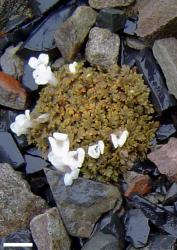- ≡ Parahebe cheesemanii (Benth.) W.R.B.Oliv., Rec. Domin. Mus. 1: 230 (1944)
Cushion or mat-forming sub-shrub to 0.04 m tall. Stems prostrate to ascending, sometimes rhizomatous, eglandular-pubescent; hairs uniform. Leaf bud indistinct; leaves separating while small, opposite-decussate, erect to recurved. Lamina sub-coriaceous, ovate, elliptic, orbicular, rhomboid, deltoid, or spathulate, 2–5 mm long, 2–3 mm wide, dull dark, grey-, or bronze-green above, similar or pinkish beneath; midrib evident; surfaces eglandular-hairy above and beneath, rarely glabrous; margins denticulate or minutely papillate, deeply crenate-serrate or pinnatifid, sometimes bipinnatifid; teeth or lobes in 2–5 pairs; apex sub-acute to obtuse; base cuneate or abruptly cuneate; petiole 3–6 mm long. Inflorescence a solitary axillary bibracteate flower, rarely a raceme of 2–3 flowers, 2–10 mm long, eglandular hairy, all bisexual; bracts opposite, spathulate, > pedicels; pedicels erect, 0–2 mm long, eglandular hairy all around. Calyx lobes 4, rarely a small 5th lobe, obtuse to sub-acute, equal, 4–7 mm long, eglandular-hairy. Corolla 4–7 mm diameter; tube white, 3.5–7.0 mm long, ≥ calyx, hairy outside or glabrous; lobes 4, sometimes 5, white, spreading to recurved, sub-equal to unequal, elliptic to orbicular or deltoid, 2–3 mm long, obtuse to rounded or posterior emarginate; nectar guides absent. Stamen filaments white, 1.5–2.0 mm long; anthers pink to magenta. Style glabrous, 1.5–3.0 mm long. Capsules angustiseptate, emarginate to didymous, eglandular-hairy, 3–4 mm long, 3–4 mm at widest point. Seeds ellipsoid to obovoid, barely flattened, finely papillate, pale to dark brown, 0.6–1.1 mm long.
| 1 | Lamina (excluding petiole) ovate, deltoid, spathulate, or rhomboid, pinnatifid, lobed to ¾-way or more; petiole hairs 0.5–1 mm long | subsp. cheesemanii |
| Lamina (excluding petiole) elliptic or orbicular, crenate to shallowly pinnatifid, lobed to about halfway; petiole hairs 0.3–0.5 mm long | subsp. flabellata |
Veronica cheesemanii plants are very distinctive and seem most similar to V. spathulata. V. spathulata plants have a more lax growth form, larger flowers, and more of them per inflorescence; their calyx lobes are entire or sometimes shallowly toothed.
V. cheesemanii is the only New Zealand species of Veronica with pinnatifid or lobed bracts and calyx lobes. A few other species occasionally have toothed or crenate bracts, and the calyx lobes in V. spathulata are occasionally bluntly toothed.
Lobed or pinnatifid leaves, bracts, and calyx lobes and its overall dark greyish- or brownish-green colour distinguish it from other cushion-forming veronicas, which all have these parts entire.
South Island: Western Nelson, Sounds Nelson (Richmond Range), Marlborough (Raglan Range), Canterbury (Arthur’s Pass National Park), Westland (Nelson Lakes National Park, Arthur's Pass National Park).
Alpine stable rock fields and fell-fields, occasionally more mobile screes, in fine gravel or small stones overlying silty soil.
| Category | Number |
|---|---|
| Indigenous (Endemic) | 2 |
| Total | 2 |
Flowers: December–March; fruits: January–May, persisting all year.
2n = 42 (var. cheesemanii only; see Hair 1970).
Veronica cheesemanii is classified in V. subg. Pseudoveronica sect. Hebe but is not currently assigned to any informal group (Albach & Meudt 2010). In its morphology its habit suggests a relationship to V. spathulata, and this is supported by these two species sharing a unique feature: the division or toothing of the calyx lobes. However, molecular phylogenetic research so far does not support a close relationship between them (Albach & Meudt 2010).




